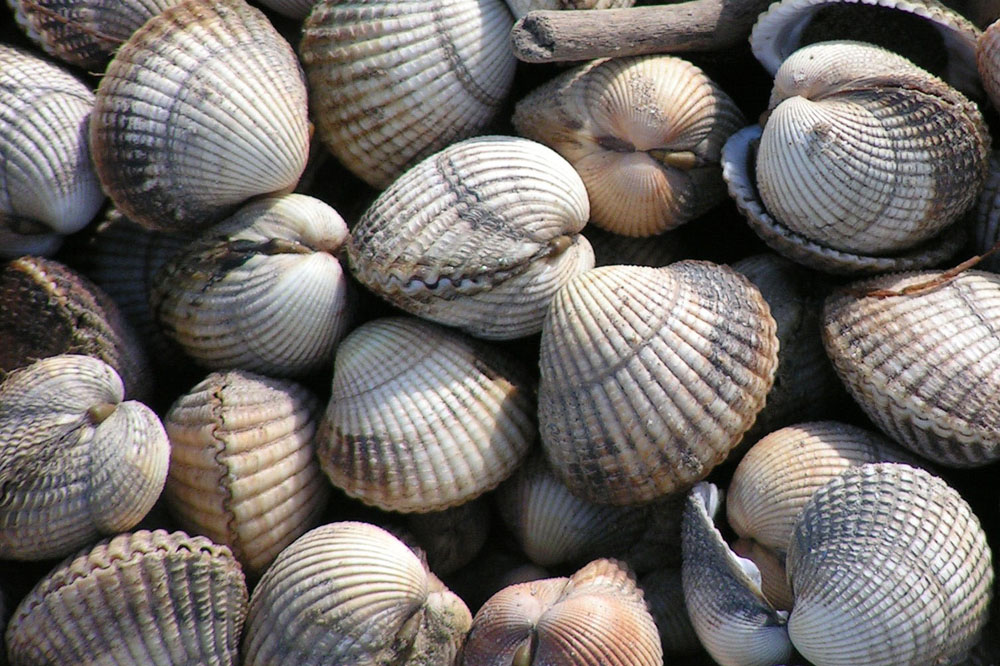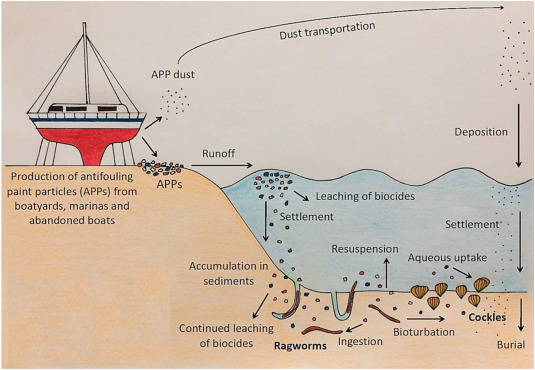Story
New research shows stricter regulation is needed on the fate of legacy, toxic antifouling treatments
21 October 2020

Results indicate that paint particles stemming from biocidal antifouling coatings, containing high levels of copper, have the potential to adversely affect the health of seabed-dwelling (benthic) creatures at environmentally relevant concentrations.
Antifouling paints are used on objects that are in contact with water for a length of time to reduce biofouling; the accumulation of unwanted organisms on submerged structures. It is important to keep biofouling to a minimum as it can cause equipment to break, pose a health & safety risk and increases drag on vessels, leading to higher fuel usage.
Traditionally the paints used to prevent biofouling work by releasing ‘biocides’ into the surrounding water, which either kills or deters organisms from making the submerged surface their new home. However, the paints do not discriminate and can have adverse effects on non-target species.
In 2008, the use of organotin tributyltin (TBT) was banned from use in antifouling paints as TBTs have been directly linked to widespread and persistent negative impacts on many types of marine organisms. In recent years the coatings industry has introduced biofouling-control products that are less dependent on biocides, such as biocide-free silicone-based technologies but the long-term impacts of these are not well established. In addition, modern and historic biocidal antifouling paint particles are still being found in sediments close to marinas and abandoned boats, due to maintenance and weathering, and it is largely unknown as to whether these particles pose a toxic threat to benthic life.
This study, published in the journal Environmental Pollution and involving scientists from Plymouth Marine Laboratory, the University of Plymouth and PML Applications Ltd., investigated the lethal and sub-lethal consequences of exposure to environmentally relevant concentrations of biocidal (‘modern’ and ‘historic’) and biocide-free/silicone antifouling paint particles on harbour ragworms (Hediste diversicolor) and common cockles (Cerastoderma edule).
The team found that for ragworms, significant decreases in weight (15.7%) and feeding rate (10.2%) were observed when exposed to the modern biocidal treatment, and burrowing behaviour was also reduced (29%). For cockles, the modern biocidal treatment led to 100% mortality. Overall, ragworms had a higher tolerance to modern antifouling paint particles than cockles.
The results of this study indicate that modern, biocidal antifouling paint particles containing high copper concentrations have the potential to adversely affect the health of benthic organisms at environmentally relevant concentrations. Meanwhile, the non-biocidal, silicone-based paint particles were generally less toxic, however, they did induce sub-lethal responses such as weight loss in cockles. Such an impact could have severe implications for estuarine ecosystem health over natural time scales and requires more investigation.
 In a previous study by this team, antifouling paint particles were found to be unevenly distributed in sediments, with maximum concentrations of 430 particles per litre near a facility where boats are regularly maintained and 400 particles per litre where old boats had been abandoned. The majority of particles encountered were in the finest size fraction and contained a variable concentration of copper, zinc, tin and lead, meaning that these particles can be considered as microplastics with high metal loads. The presence of these metals is attributed to an assortment of contemporary and historic antifouling formulations, which ultimately result in the significant and diverse metal contamination of local sediments and organisms living within.
In a previous study by this team, antifouling paint particles were found to be unevenly distributed in sediments, with maximum concentrations of 430 particles per litre near a facility where boats are regularly maintained and 400 particles per litre where old boats had been abandoned. The majority of particles encountered were in the finest size fraction and contained a variable concentration of copper, zinc, tin and lead, meaning that these particles can be considered as microplastics with high metal loads. The presence of these metals is attributed to an assortment of contemporary and historic antifouling formulations, which ultimately result in the significant and diverse metal contamination of local sediments and organisms living within.
Christina Muller-Karanassos, co-lead author and MRes Marine Biology graduate, University of Plymouth, commented: "Last year, our research in the field revealed that antifouling paint particles can be readily identified in estuarine sediments near marinas, boatyards and abandoned boats."
William Arundel, co-lead author and MSc Marine Science graduate, University of Plymouth, continued: “The distribution of paint particles was noticeably heterogeneous, even within sites; at the most contaminated site we found an average litre of sediment contained 4.2 g of paint particles, with a maximum of 18.8 g of paint particles per litre. Of particular concern was the apparent ingestion of anti-fouling paint particles by ragworms found in the study area.”
Dr Matthew Cole, co-author and Marine Ecologist and Ecotoxicologist at PML, said: "In this study we wanted to understand whether antifouling paint particles posed a risk to animals living in estuarine sediment. Cockles and ragworms, which are common to UK estuaries, were exposed to paint particles made from either biocidal paints (containing copper), or modern, silicone-based paints without metals, at environmental concentrations. We found cockles were particularly sensitive to biocidal paint particles, with 2.3 g of paint particles per litre of sediment causing 50% population loss. Ragworms proved to be hardier, but still suffered from reduced feeding and weight loss following prolonged exposure to biocidal paints."
Professor Penelope Lindeque, co-author and PML Head of Science for Marine Ecology and Biodiversity, stated: "We have shown antifouling paint particles are making their way into the natural environment where they can cause harm to non-target organisms. Cockles and ragworms are estuarine species that play vital roles in sediment ecology and marine food chains. While exposure to silicone-based non-biocidal APPs resulted in increased weight-loss in cockles, current evidence indicates non-biocidal antifouling paints to be less toxic to non-target organisms."
While the toxicity of these antifouling paint particles requires further investigation, there is clearly a need for stricter regulations on antifouling wastes in boatyards and marinas and a requirement to improve the management of abandoned boats to reduce the risk of damage to sediment quality and potentially, marine organisms and ecosystem health.
Dr Andrew Turner, co-author and Associate Professor at the University of Plymouth, said: “Antifouling paint particles are types of microplastic, but extremely toxic ones. Much tighter regulation is required for boatyards, where vessel hulls are regularly cleaned and maintained, and for the disposal of end-of-life boats.”
Dr Thomas Vance, co-author and Manager of the Centre for Marine Biofouling and Corrosion at PML Applications Ltd, commented: “Following on from this work we are keen to investigate how the sub-lethal but still detrimental effects of the non-biocidal antifouling paint particles influence marine organisms over longer time scales."
Related information
Environmental concentrations of antifouling paint particles are toxic to sediment-dwelling invertebrates was published in the journal Environmental Pollution